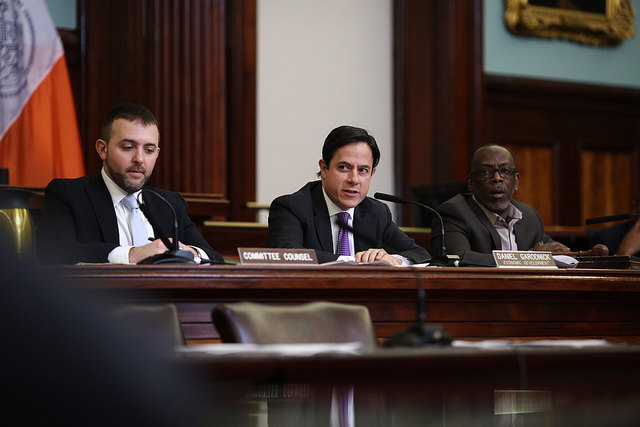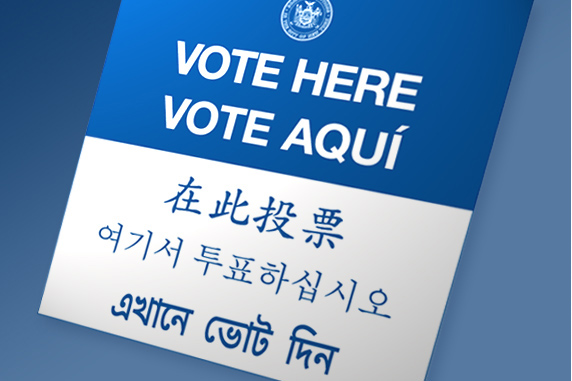For a More Accountable NYPD, Improve Information Sharing on Police Misconduct

Council Member Dan Garodnick, the author (photo: William Alatriste)
For decades, the New York City Police Department has had an early intervention system to identify officers prone to violence, based on their discipline and complaint history. Yet through leaks last month, we learned that the officers who killed Eric Garner and Ramarley Graham had extensive records of complaints against them. Despite so many documented problems, the officers remained in a position to harm the very people they were sworn to protect. In these cases, the early intervention system did not do its job.
We must do better and hold the NYPD more accountable for ensuring that its officers and the public are receiving all the benefits of a robust early intervention system. Several city agencies, from the Law Department to the Civilian Complaint Review Board (CCRB), oversee the NYPD to some extent. Each of them should have complete access to the information that exists on police misconduct -- but today they do not. Officers with unusually high rates of alleged misconduct should be well known not only to the police department but also to all the entities that do oversight.
To accomplish this, I have written a bill that would require the Police Department, the Law Department, the Comptroller, the CCRB, and the Inspector General for the NYPD to share with each other information regarding civil actions, complaints, and other data points relating to allegations of police misconduct by officers.
Such information-sharing is key. In the absence of reliable and consistent access to this information, these oversight entities cannot properly discharge their responsibilities. Ultimately, an early intervention system that fails to intervene is not much of a system at all.
And we desperately need that system to work. Studies have found that a very small percentage of officers are responsible for the overwhelming majority of problematic interactions with civilians. Identifying those officers, and correcting their behavior or removing them from interaction with the public, would go a long way to rooting out the problem of excessive use of force by the police.
More eyes on police misconduct will mean greater accountability for the NYPD’s early intervention system. With a better system, we could ensure that the NYPD acts faster to address festering issues, and to protect the public. We would also ensure that our many talented and capable police officers do not have to be partnered with people who are going to put anyone’s life in danger.
We could also save the city a lot of money. In Fiscal Year 2016, New York City paid out $228 million in settling and paying out police misconduct judgments. Effective interventions to remove or retrain the few officers who are responsible for the most problems would reduce the city’s exposure to litigation and consequently reduce the costs associated with police misconduct.
Most importantly, this legislation could prevent tragedy. If a better information sharing system is in place, the NYPD will have to be more responsive to addressing misconduct of officers with histories of complaints. In the tragic case of Eric Garner, the NYPD knew Officer Daniel Pantaleo’s history, but did not take sufficient steps to address the underlying issues. In Pantaleo's previous disciplinary proceedings, the NYPD failed to follow the CCRB's recommendations for punishment. Further, they allowed him to continue to work on the street. If other oversight agencies also knew of the complaints and the recommended consequences, there might have been more pressure on the NYPD to heed these warning signs and work to prevent future incidents.
Mayor de Blasio and Commissioner O’Neill have made significant progress in bridging divides between communities and police. They have an opportunity to continue this progress by supporting this bill, which will be the subject of a public hearing in front of the City Council’s Public Safety Committee on Thursday, a hearing chaired by bill co-sponsor Vanessa Gibson. If we want to better protect civil liberties and to better identify officers that have a history of violence, let’s give all the oversight bodies the tools they need to conduct real analysis. It very well may save lives.
***
Daniel Garodnick has represented the fourth district in the New York City Council since 2006, and chairs the Economic Development Committee. On Twitter @DanGarodnick.
***
Have an op-ed idea or submission for Gotham Gazette? Email This email address is being protected from spambots. You need JavaScript enabled to view it.
Avoiding a False Debate on Reentry Programming

(photo: The Governor's Office)
To the Editor:
I am the author of one of the books referred to in Robert Cherry’s March 28, 2017 opinion piece, Choosing Post-Prison Reentry Programs That Work. The title of my book, Liberating Minds: The Case for College in Prison (The New Press), was not indicated in the essay and I wonder if Mr. Cherry read the book, even though he wrote an essay criticizing it. All his comments were based on a favorable, but not fully accurate essay that appeared in the New York Review of Books on February 23.
Mr. Cherry claimed Liberating Minds “argued against vocational” programs in prison. While I did laud the Bard Prison Initiative (with which I am affiliated), it is not the case that I “argued against” vocational education. Rather I endorsed programs of many different kinds so long as they are of high quality.
Unfortunately, too many vocational programs teach job-specific skills rather than generic skills of logic and reasoning, which will equip one over a lifetime for a rapidly changing job market. I was, and am, critical of such programs, but not of vocational education generally. Endorsing high quality in all forms of higher education is in no way a condemnation of vocational education, or an endorsement of the liberal arts. It is to call for standards that promote learning to learn and therefore ensure that an education has lasting benefit.
College-in-prison and reentry programs are important topics for discussion, but not when the central issues are clouded by inaccuracies. Your readers need to learn how and why such programs are a cost-effective investment that benefits everyone; they do not need to be distracted by a false debate about liberal versus vocational education.
Sincerely,
Ellen Condliffe Lagemann, Levy Institute Research Professor, Bard College, and Distinguished Fellow, Bard Prison Initiative
And in response to this letter, Professor Cherry writes:
I criticized the reviewer (from the New York Review of Books) for arguing against occupational programs not the books’ authors. The author now reinforces my assertion since she too rejects all certificate programs because they “teach job-specific skills rather than generic skills of logic and reasoning ...” Most importantly, she chastises me for creating “a false debate about liberal versus vocational education.” It is not I who run reentry programs that exclude certificate programs from the options supported for those with a high school equivalence degree. I am simply responding to these actions that adversely affect many of the previously incarcerated.
***
Have an op-ed idea or submission for Gotham Gazette? Email This email address is being protected from spambots. You need JavaScript enabled to view it.
Latino Voters and the 2017 New York City Elections

For the first time in history, there are more Latino voters in New York City than African Americans. In fact, Latinos now account for 23% (977,514) of all registered voters in NYC (4,281,946) and they are a quarter (735,641) of all registered Democrats (2,942,337), according to data from Prime New York’s voter analysis.
As the largest ethnic group in the city – and the entire United States – the Latino presence in New York is palpable: from the store-front taquerias and cuchifritos, to the salsa and merengue beat in the streets, to the baseball and soccer stars that dominate our airwaves.
This presence has also been felt electorally, but, until now, the Latino voting explosion has not increased their political representation. In fact, Latino-majority districts are now under direct threat from the drawing of specific districts, and the gentrification of traditionally Latino neighborhoods such as El Barrio (East Harlem) and Loisaida (the Lower East Side).
In Loisaida, the 2nd Council District has been represented by a Latino/a for almost thirty years. Though currently represented by Rosie Mendez, real estate development and gentrification has created a spike of younger white voters – who now outnumber Latinos by over 12,000 registered voters.
Other city districts do not face this direct threat to Latino political representation, but if the current demographic dynamics continue, it will become a widening reality.
Districts that have experienced a drastic shift include the 38th Council District, currently represented by Carlos Menchaca. On a larger scale the 7th Congressional District, which contains some of the 38th Council District, is showing this same influx of younger white voters, and many of them are not familiar with the incumbent Rep. Nydia Velazquez.
In spite of these electoral changes, the impact of Latinos cannot be ignored by future candidates, incumbents, or anyone. Some recent elections make this point, and very dramatically.
The last time a Latino topped the ticket in a municipal election was in 2005, when Fernando Ferrer won the mayoral Democratic primary. In that election, Latinos already constituted a quarter of the entire Democratic electorate, and over 90,000 Latinos voted in the primary. In 2013, the year in which Mayor de Blasio won his election, we saw a decline in the percentage of Latinos voting, but an actual increase in the actual number of Latinos who turned out. The increase totaled over 20,000 new voters, for a total of over 111,000 Latino votes in 2013. This increase occurred despite the absence of any Latino citywide candidate in that year. (Data based on Prime New York data and my own analysis.)
Current efforts to register more Latinos to vote and the rise of younger and active Latino community leaders will undoubtedly lead to greater Latino voter participation. My own statistical modeling and data analysis shows as many as 40,000 additional Latinos potentially voting in the upcoming 2017 New York City primary. Any candidate who ignores this powerhouse voting bloc – from the mayor on down – will do so at their peril.
In 2017 every candidate must be aware of, and sensitive to, the issues that affect Latinos in New York. Those issues can no longer be taken for granted. As a dominant citywide voting bloc, Latinos must be placed front and center in any policy or electoral agenda.
The recognition of Latino issues is not merely ethical. It is also good politics, because along with their growing electoral power, Latinos are developing a memory. They will remember who has taken them seriously, and who has not. Every elected official in New York, every current and future politician, should remember this fact.
***
Eli Valentin is a Democratic consultant and pastor of the Iglesia Evangelica Bautista in New York City. He is a frequent political analyst on Univision and NY1’s Inside City Hall. On Twitter @EliValentinNY.




